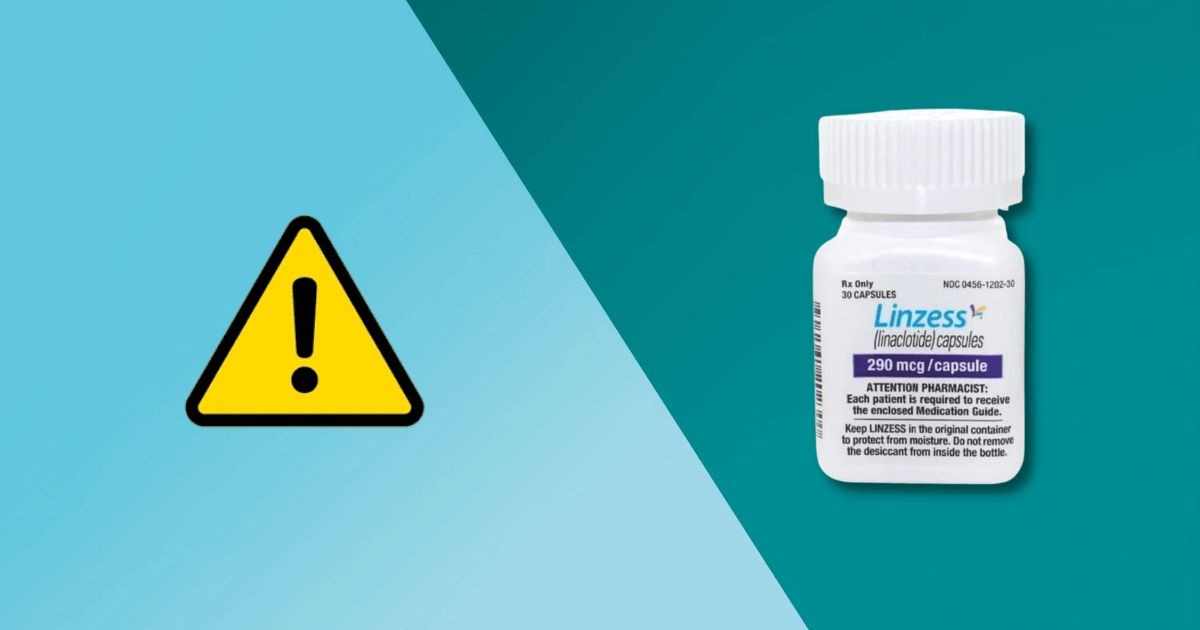
Contents
- 1 Side Effects of Linzess
- 1.0.1 What are the side effects of Linzess?
- 1.0.2 Linzess side effects for healthcare professionals
- 1.0.3 What drugs interact with Linzess?
Side Effects of Linzess
Linzess (linaclotide) is a guanylate cyclase-C drug used to relieve symptoms of irritable bowel syndrome (IBS) with constipation, treat chronic constipation of unknown cause (idiopathic constipation), and functional constipation in children and adolescents 6 to 17 years of age.
Linzess increases bowel movements and reduces pain locally in the intestine by increasing fluid secretion and reducing the sensitivity of pain-sensing nerves.
Common side effects of Linzess include:
Serious side effects of Linzess include:
- severe diarrhea,
- headache,
- fatigue,
- respiratory infections,
- sinusitis,
- stomach or intestinal viral infections, and rarely,
- passage of blood from the rectum.
Drug interaction studies have not been conducted with Linzess. Linzess has not been adequately evaluated in pregnant women. It is unknown if Linzess is excreted in breast milk.
It is unlikely Linzess is excreted in breast milk because it is poorly absorbed and undetectable in blood at recommended doses. Consult your doctor before breastfeeding.
What are the side effects of Linzess?
The most common side effects of linaclotide are:
- diarrhea,
- stomach pain,
- gas, and
- stomach distention.
Linaclotide should be stopped if patients develop severe diarrhea. Other important side effects include:
- headache,
- fatigue,
- respiratory infections,
- sinusitis, and
- stomach or intestinal viral infections.
Rarely, patients may experience passage of blood from the rectum.
Linzess side effects for healthcare professionals
Clinical Trials Experience
Because clinical trials are conducted under varying conditions, adverse reaction rates observed in the trials of one drug may not reflect the rates observed in practice.
Exposure in clinical development included patients with IBS-C or CIC treated with Linzess for different periods of time.
Demographic characteristics were comparable between treatment groups in all studies.
Irritable Bowel Syndrome With Constipation (IBS-C)
Most Common Adverse Reactions
The following table provides the incidence of adverse reactions reported in at least 2% of IBS-C patients in the Linzess treatment group.
Table 1: Most Common Adverse Reactions in Two Placebo-Controlled Trials (1 and 2) in Patients with IBS-C
| Adverse Reactions | Linzess 290 mcg [N=807] % |
Placebo [N=798] % |
| Gastrointestinal | ||
| Diarrhea | 20 | 3 |
| Abdominal pain | 7 | 5 |
| Flatulence | 4 | 2 |
| Abdominal distension | 2 | 1 |
| Infections and Infestations | ||
| Viral Gastroenteritis | 3 | 1 |
| Nervous System Disorders | ||
| Headache | 4 | 3 |
| a: Reported in at least 2% of Linzess-treated patients and at an incidence greater than placebo | ||
Diarrhea
- Diarrhea was the most commonly reported adverse reaction of the Linzess-treated patients in the pooled IBS-C placebo-controlled trials.
- 20% of Linzess-treated patients reported diarrhea compared to 3% of placebo-treated patients.
- Severe diarrhea was reported in 2% of Linzess-treated patients versus less than 1% of placebo-treated patients, and 5% of Linzess-treated patients discontinued due to diarrhea vs less than 1% of placebo-treated patients.
- The majority of reported cases of diarrhea started within the first 2 weeks of Linzess treatment.
Adverse Reactions Leading to Discontinuation
- In placebo-controlled trials in patients with IBS-C, 9% of patients treated with Linzess and 3% of patients treated with placebo discontinued prematurely due to adverse reactions.
- In the Linzess treatment group, the most common reasons for discontinuation due to adverse reactions were diarrhea (5%) and abdominal pain (1%).
- In comparison, less than 1% of patients in the placebo group withdrew due to diarrhea or abdominal pain.
Adverse Reactions Leading to Dose Reductions
- In the open-label, long-term trials, 29% of patients had their dose reduced or suspended secondary to adverse reactions, the majority of which were diarrhea or other GI adverse reactions.
Less Common Adverse Reactions
Chronic Idiopathic Constipation (CIC)
Most Common Adverse Reactions
The following table provides the incidence of adverse reactions reported in at least 2% of CIC patients in the Linzess treatment group.
Table 2: Most Common Adverse Reactions in the Two Placebo-Controlled Trials (3 and 4) in Patients with CIC
| Adverse Reactions | Linzess 145 mcg [N=430] % |
Placebo [N=423] % |
| Gastrointestinal | ||
| Diarrhea | 16 | 5 |
| Abdominal pain | 7 | 6 |
| Flatulence | 6 | 5 |
| Abdominal distension | 3 | 2 |
| Infections and Infestations | ||
| Upper respiratory tract infection | 5 | 4 |
| Sinusitis | 3 | 2 |
| a: Reported in at least 2% of Linzess-treated patients and at an incidence greater than placebo | ||
The safety of a 72 mcg dose was evaluated in an additional placebo-controlled trial in which patients were randomized to Linzess 72 mcg, 145 mcg, or placebo once daily for 12 weeks.
Adverse reactions that occurred at a frequency of ≥ 2% in Linzess-treated patients and at a higher rate than placebo were:
- Diarrhea (Linzess 72 mcg 19%; Linzess 145 mcg 22%; placebo 7%)
- Abdominal distension (Linzess 72 mcg 2%; Linzess 145 mcg 1%; placebo < 1%)
Diarrhea
This section summarizes information regarding diarrhea, the most commonly reported adverse reaction in Linzess-treated patients in CIC placebo-controlled studies.
In all trials, the majority of reported cases of diarrhea started within the first 2 weeks of Linzess treatment.
Severe diarrhea was reported in less than 1% of the 72 mcg Linzess-treated patients, 2% of the 145 mcg Linzess-treated patients, and less than 1% of the placebo-treated patients.
Adverse Reactions Leading to Discontinuation
- In placebo-controlled trials in patients with CIC, 3% of patients treated with 72 mcg and between 5% and 8% of patients treated with 145 mcg of Linzess discontinued prematurely due to adverse reactions compared to between less than 1% and 4% of patients treated with placebo.
- In patients treated with 72 mcg Linzess, the most common reason for discontinuation due to adverse reactions was diarrhea (2%). In patients treated with 145 mcg Linzess, the most common reasons for discontinuation due to adverse reactions were diarrhea (3% to 5%) and abdominal pain (1%). In comparison, less than 1% of patients in the placebo group withdrew due to diarrhea or abdominal pain.
Adverse Reactions Leading to Dose Reductions
- In the open-label, long-term trials, 27% of patients had their dose reduced or suspended secondary to adverse reactions, the majority of which were diarrhea or other GI adverse reactions.
Less Common Adverse Reactions
Postmarketing Experience
- The following adverse reactions have been identified during post approval use of Linzess.
- Because these reactions are reported voluntarily from a population of uncertain size, it is not always possible to reliably estimate their frequency or establish a causal relationship to drug exposure.
- Hematochezia, rectal hemorrhage, nausea, and allergic reactions, urticaria or hives.
What drugs interact with Linzess?
Drug interactions with Linzess have not been studied.


